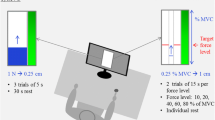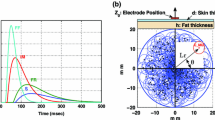Abstract
The aim of this study was to develop and evaluate a model based upon four identified characteristics of the power spectral density associated with isometric force at a range of constant force levels (5–95% maximum voluntary contraction). The characteristics modeled were: (1) a low-frequency resonant peak located at about 1 Hz; (2) a region of 1/f-like fractional Gaussian noise (fGn); (3) the resonant peak in the 8–12 Hz region on the PSD; and (4) Gaussian white noise resulting from a combination of neural as well as equipment noise. When superimposed, these components were used in a direct fit to the isometric force data to generate a linear predictor that resulted in residual values on the order of the white noise present in the original force time series.
Similar content being viewed by others
References
Bassingthwaighte JB, Liebovitch LS, West BJ (1994) Fractal physiology. Oxford University Press, Oxford
Beuter AH, Edwards R, Titcombe M (2003) Data analysis and mathematical modeling of human tremor. In: Beuter AH et al (eds) Nonlinear dynamics in biology and medicine, vol 1. Springer, New York
Deutsch KM, Newell KM (2001) Age differences in noise and variability of isometric force production. J Exp Child Psychol 80: 392–408
Elble RJ, Koller WC (1990) Tremor. The Johns Hopkins University Press, Baltimore
Findley LJ, Capildeo R (1984) Disorders: Tremor. Oxford University Press, New York
Fitts PM (1954) The information capacity of the human motor system in controlling the amplitude of movement. J Exp Psychol 47: 381–391
Fitts PM, Peterson JR (1964) Information capacity of discrete motor responses. J Exp Psychol 67: 103–112
Frank TD, Friedrich R, Beek PJ (2004) Identifying noise sources of time-delayed feedback systems. Phys Lett A 328: 219–224
Frank TD, Beek PJ, Friedrich R (2005) Identifying and comparing states of time-delayed systems: phase diagrams and applications to human motor control systems. Phys Lett A 338: 74–80
Harris CM, Wolpert DM (1998) Signal-dependent noise determines motor planning. Nature 394: 725–726
Hayes MH (1996) Statistical digital signal processing and modeling. Wiley, New York
Herriman A (2003) http://www.firstpr.com.au/dsp/pink-noise/
Jagacinski RJ, Flach J (2003) Control theory for humans: quantitative approaches to modeling performance. Lawrence Erlbaum and Associates, Mahwah
Mayer-Kress G, Newell KM (2002) Stochastic iterative maps with multiple time-scales for modeling human motor behavior. Nonlinear Phenom Complex Syst 4: 1–8
Mayer-Kress G, Deutsch KM, Newell KM (2003) Modeling the control of isometric force production with piece-wise linear, stochastic maps of multiple time-scales. Fluct Noise Lett 3: L23–L29
Newell KM, James E (2008) The amount and structure of human movement variability. In: Hong Y, Bartlett R (eds) Handbook of biomechanics and human movement science. Routledge, Abington, pp 93–104
Newell KM, Slifkin AB (1998) The nature of movement variability. In: Piek J (eds) Motor control and human skill: a multidisciplinary perspective. Human Kinetics, Champaign, pp 143–160
Newell KM, Sprague RL (1996) Tardive dyskinesia and coupling constraints in inter-limb postural tasks. Hum Mov Sci 15: 237–251
Newell KM, Deutsch KM, Sosnoff JJ, Mayer-Kress G (2006) Motor output variability as noise: a default and erroneous proposition?. In: Davids K, Bennett S, Newell K (eds) Variability in the movement system: a multidisciplinary perspective. Human Kinetics, Champaign
Riley MA, Turvey MT (2002) Variability and determinism in motor behavior. J Mot Behav 34: 99–125
Shannon CE, Weaver W (1949) The mathematical theory of communication. University of Illinois Press, Urbana
Slifkin AB, Newell KM (1999) Noise, information transmission, and force variability. J Exp Psychol 25: 837–851
Slifkin AB, Vaillancourt DE, Newell KM (2000) Intermittency in the control of continuous force production. J Neurophysiol 84: 1708–1718
Sosnoff JJ, Newell KM (2005) Intermittent visual information and the multiple timescales of visual motor control of continuous isometric force production. Percept Psychophys 67: 335–344
Stitt JP, Newell KM (2006) A nonlinear system model of isometric force. Proceedings of the 28th annual international conference of the IEEE engineering in medicine and biology society, vol 1, pp 1347–1350
Stitt JP, Newell KM (2009) Stochastic modeling of the steady-state variability in isometric force. Motor Control 13: 310–330
van Galen GP, de Jong WP (1995) Fitts’ law as the outcome of a dynamic noise model of motor control. Hum Mov Sci 14: 539–571
van Galen GP, van Doom RRA, Schomaker LRB (1990) Effects of motor programming on the spectral density function of finger and wrist movements. J Exp Psychol 16: 755–765
West BJ (2006) Where medicine went wrong: rediscovering the path to complexity. World Scientific, Hackensack
Wing A, Daffertshofer A, Pressing J (2004) Multiple time scales in serial production of force: a tutorial on power spectral analysis of motor variability. Hum Mov Sci 23: 569–590
Author information
Authors and Affiliations
Corresponding author
Rights and permissions
About this article
Cite this article
Stitt, J.P., Newell, K.M. Four-component power spectral density model of steady-state isometric force. Biol Cybern 102, 137–144 (2010). https://doi.org/10.1007/s00422-009-0356-z
Received:
Accepted:
Published:
Issue Date:
DOI: https://doi.org/10.1007/s00422-009-0356-z




